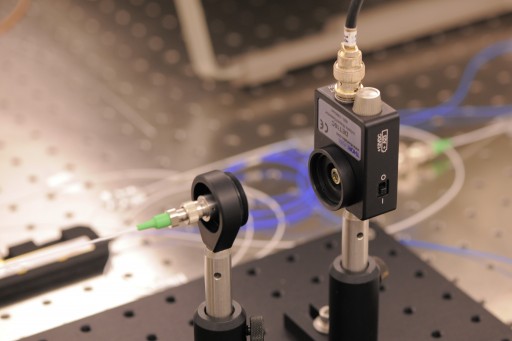NASA pursues atom optics to detect gravitational waves
October 21, 2012

Goddard-designed breadboard laser system, critical to advancing atom-optics instruments (credit: Pat Izzo/NASA)
A pioneering technology capable of atomic-level precision is now being developed to detect what so far has remained imperceptible: gravitational waves or ripples in space-time caused by cosmic cataclysmic events, including even the Big Bang itself.
A team of researchers at NASA’s Goddard Space Flight Center, Stanford University, and AOSense, Inc. recently won funding under the NASA Innovative Advanced Concepts (NIAC) program to advance atom-optics technologies.
Some believe this emerging, highly precise measurement technology is a technological panacea for everything from measuring gravitational waves to steering submarines and airplanes and a variety of space applications, including navigating around a near-Earth asteroid to measure its gravitational field and deduce its composition.
Predicted by Albert Einstein’s general theory of relativity, gravitational waves , which have not yet been detected, occur when massive celestial objects move and disrupt the fabric of space-time around them. By the time these waves reach Earth, they are so weak that the planet expands and contracts less than an atom in response. This makes their detection with ground-based equipment more challenging because environmental noise, like ocean tides and earthquakes, can easily swamp their faint murmurings.

Artist’s rendition of a binary-star merger, which may create gravitational waves that cause ripples in space-time (credit: NASA Goddard Space Flight Center)
Confirmation of their existence, would revolutionize astrophysics, providing a new tool for studying everything from inspiralling black holes to the early universe.
The team believes atom optics or atom interferometry holds the key to directly detecting them. Atom interferometry works much like optical interferometry, comparing light that has been split into two equal halves with a device called a beamsplitter. One beam reflects off a mirror that is fixed in place; from there, it travels to a camera or detector. The other shines through something scientists want to measure. It then reflects off a second mirror, back through the beamsplitter, and then onto a camera or detector.
Because the path that one beam travels is fixed in length and the other travels an extra distance or in some other slightly different way, the two light beams overlap and interfere when they meet up, creating an interference pattern that scientists inspect to obtain highly precise measurements.
Atom interferometry
Atom interferometry, however, hinges on quantum mechanics, the theory that describes how matter behaves at sub-microscopic scales. Just as waves of light can act like particles called photons, atoms can be cajoled into acting like waves if cooled to near absolute zero. At those frigid temperatures, which scientists achieve by firing a laser at the atom, its velocity slows to nearly zero. By firing another series of laser pulses at laser-cooled atoms, scientists put them into what they call a “superposition of states.”
In other words, the atoms have different momenta, permitting them to separate spatially and be manipulated to fly along different trajectories. Eventually, they cross paths and recombine at the detector — just as in a conventional interferometer. “Atoms have a way of being in two places at once, making it analogous to light interferometry,” said Mark Kasevich, a Stanford University professor and team member credited with pushing the frontiers of atom optics.
The power of atom interferometry is in its precision. If the path an atom takes varies by even a picometer (trillionth of a meter), an atom interferometer would be able to detect the difference. Given its atomic-level precision, “gravitational-wave detection is arguably the most compelling scientific application for this technology in space,” said physicist Babak Saif, who is leading the effort at Goddard.
Since joining forces, the team designed a powerful, narrowband fiber-optic laser system that it plans to test at one of the world’s largest atom interferometers — a 33-foot drop tower in the basement of a Stanford University physics laboratory. Close scientifically to what the team would need to detect theoretical gravitational waves, the technology would be used as the foundation for any atom-based instrument created to fly in space, Saif said.
During the test, the team will insert a cloud of neutral rubidium atoms inside the 33-foot tower. As gravity asserts a pull on the cloud and the atoms begin to fall, the team will use its new laser system to fire pulses of light to cool them. Once in the wave-like state, the atoms will encounter another round of laser pulses that allow them to separate spatially. Their trajectories then can be manipulated so that their paths cross at the detector, creating the interference pattern.
The team also is fine-tuning a gravitational-wave mission concept it has formulated. Similar to the Laser Interferometer Space Antenna (LISA), the concept calls for three identically equipped spacecraft placed in a triangle-shaped configuration. Unlike LISA, however, the spacecraft would use atom interferometers and would orbit much closer to one another — between 500 and 5,000 kilometers apart, compared with LISA’s five-million-kilometer separation. Should a gravitational wave roll past, the interferometers would be able to sense the miniscule movement.